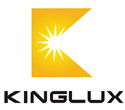|
Basic principle of a LED (light emitting diode)
A light emitting diode consists of multiple layers of semi-conducting material. When the diode is being used with direct current, light is produced in the active layer. The light produced is decoupled directly or by reflections. In contrast to incandescent reflector lamps, which emit a continuous spectrum, an LED emits light in a particular color. The light's color depends on the semiconductor material used. Two material systems are mainly used, in order to produce LEDs with a high degree of brightness in all colors from blue to red and, by means of luminescence conversion, also in white. Different voltages are necessary, to operate the diode in forward bias.

LEDs are semiconductor crystals. Depending on the composition of the crystal compounds, they emit light in the colors of red, green, yellow or blue, when current flows through them. With the help of an additional yellowish fluorescent layer, blue LEDs also produce white light (luminescence conversion). Another method of producing white light consists in mixing red, green and blue light-emitting diodes (RGB). This is used particularly where the priority is not general white lighting but rather decorative effects with various rich colors.
With the three RGB colors, any number of color tones may be mixed by varying the proportions of the individual colors. In this way, the LED lighting can create fascinating worlds of experience.
LED cross section
LEDVANCE provides OSRAM LEDs with the widest variety of white light colors. They range from very warm white 2700 Kelvin through neutral white 4000 Kelvin right through to cold white 6500 Kelvin similar to daylight. The color rendering index (CRI) within the various white tones reaches values ranging from 70 to well above 90. Luminous efficacies of up to 130 lumens per watt are possible with the components currently available.

Advantages of LED technology
LEDs offer numerous advantages over other lighting technologies. Professional users and home consumers profit to the same extent from limitless design possibilities based on a variety of color, compact dimensions and flexibility of the LED modules. On the basis of the low energy consumption, long lifetime and greater service intervals, high economic benefits are produced. In addition, individual LEDs provide maximum reliability even in difficult environmental conditions.

-
Low power consumption
-
High efficiency level
-
Long lifetime
-
Continuous dimming combined with an ECG
-
Smallest possible dimensions
-
High resistance to switching cycles
-
Immediate light at switching on
-
Wide operating temperature range
-
High impact and vibration resistance
-
No UV or IR radiation
-
High color saturation level without filtering
-
Mercury-free
Unique: OSRAM's phosphorus layering process
The "Chip Level Coating" process (CLC), developed and patented by OSRAM, in which phosphorus is applied directly on top of the chip, provides homogeneity in the light output which other processes do not achieve. Meanwhile, the CLC process is also being used by other LED manufacturers.
|


